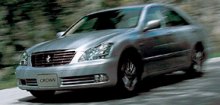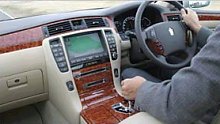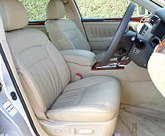 Born
in 1955, "Crown" is the oldest nameplate in Toyota’s current line-up.
Generation
after generation, Crown is still the most popular company car in Japan.
It also serves as taxis, police and government officials cars, but its
presence is bounded in domestic market. One word summarize its
character
- Conservative. To please the aging Japanese company executives and
businessmen,
you know, it HAS to be conservative in styling and trimming. It has to
ride as supple as magic carpet. In contrast, driving pleasure is not
very
important. Eventually it was isolated from the rest of the world. Born
in 1955, "Crown" is the oldest nameplate in Toyota’s current line-up.
Generation
after generation, Crown is still the most popular company car in Japan.
It also serves as taxis, police and government officials cars, but its
presence is bounded in domestic market. One word summarize its
character
- Conservative. To please the aging Japanese company executives and
businessmen,
you know, it HAS to be conservative in styling and trimming. It has to
ride as supple as magic carpet. In contrast, driving pleasure is not
very
important. Eventually it was isolated from the rest of the world.
However, since
last generation
there were signs of changes, most notably was the addition of a
sportier
version called "Crown Athlete". It showed that Toyota tried to bring it
back to international view. This change continues in the latest, 12th
generation
Crown. Although its sales is still bounded in Japan, its design is more
inline with the rest of the world. It has been engineered and trimmed
to
please driver as well as passenger. To be honest, it is still not as
driver-biased
as Lexus GS, but the improvement made is substantial enough to let you
forget any previous Crowns.
 The
new Crown still looks somewhat conservative, with a square front end
and
a traditional grille, but the body is noticeably smoother and more
handsome
than the last generation. Aerodynamic drag coefficient has been lowered
to a remarkable 0.27. The new car grows a little from the last
generation
in all dimensions. Wheelbase has been stretched to 2850mm, about the
same
as Mercedes E-class. It is built on a new FR platform that will be
shared
with the forthcoming new Lexus GS. It has double-wishbone suspension up
front and multi-link suspension at the rear. AVS adaptive variable
suspension
system, electrically assisted steering and 6-speed automatic gearbox
are
new to the Crown. The chassis employs 45% of high-strength steel to
increase
stiffness while aluminum bonnet and front sub-frame cancel the weight
increase. The
new Crown still looks somewhat conservative, with a square front end
and
a traditional grille, but the body is noticeably smoother and more
handsome
than the last generation. Aerodynamic drag coefficient has been lowered
to a remarkable 0.27. The new car grows a little from the last
generation
in all dimensions. Wheelbase has been stretched to 2850mm, about the
same
as Mercedes E-class. It is built on a new FR platform that will be
shared
with the forthcoming new Lexus GS. It has double-wishbone suspension up
front and multi-link suspension at the rear. AVS adaptive variable
suspension
system, electrically assisted steering and 6-speed automatic gearbox
are
new to the Crown. The chassis employs 45% of high-strength steel to
increase
stiffness while aluminum bonnet and front sub-frame cancel the weight
increase.
 The
cabin looks fresh and comfy. More attention has been paid to the driver
environment: Lexus-style back-lit gauges, a stylish instrument panel
and
center console. Fit and finish is first rate, so is the high quality
wood
decoration, leather trim and soft-touch plastic. Light color trimming
delivers
a warm feeling unfound in German executive cars. As for space, there is
plenty, especially for rear passengers. Despite of the change in
character,
Crown still place rear seat comfort in first priority. Not only
provides
more legroom than Mercedes E-class, the rear passengers also enjoy
independent
audio and climate control, reading lamps and a small refrigerator
behind
the arm rest. It knows who the boss is. The
cabin looks fresh and comfy. More attention has been paid to the driver
environment: Lexus-style back-lit gauges, a stylish instrument panel
and
center console. Fit and finish is first rate, so is the high quality
wood
decoration, leather trim and soft-touch plastic. Light color trimming
delivers
a warm feeling unfound in German executive cars. As for space, there is
plenty, especially for rear passengers. Despite of the change in
character,
Crown still place rear seat comfort in first priority. Not only
provides
more legroom than Mercedes E-class, the rear passengers also enjoy
independent
audio and climate control, reading lamps and a small refrigerator
behind
the arm rest. It knows who the boss is.
 In
this generation, Crown has finally gave up the long-serving straight-6
engine. In place of it is a pair of V6s. The compactness of V6 should
improve
weight distribution, but its main benefit is cost sharing. In the past,
Toyota has to make inline-6 engines for its FR cars and V6 for its FF
cars.
Now all of them can share the same V6s. The Crown employs a 3.0-litre
V6
and 2.5-litre V6 depending on price. Both incorporates D-4 direct
gasoline
injection and dual VVT-i. The larger engine pumps out 256hp and 232
lbft
of torque. The smaller generates 215hp and 192lbft. Both engines are
able
to deliver at least 90% of maximum torque at 2000rpm, thanks to the
intake
and exhaust variable valve timing. Notice their outputs are much higher
than class average, thanks partly to the direct injection which allows
higher compression ratio. In
this generation, Crown has finally gave up the long-serving straight-6
engine. In place of it is a pair of V6s. The compactness of V6 should
improve
weight distribution, but its main benefit is cost sharing. In the past,
Toyota has to make inline-6 engines for its FR cars and V6 for its FF
cars.
Now all of them can share the same V6s. The Crown employs a 3.0-litre
V6
and 2.5-litre V6 depending on price. Both incorporates D-4 direct
gasoline
injection and dual VVT-i. The larger engine pumps out 256hp and 232
lbft
of torque. The smaller generates 215hp and 192lbft. Both engines are
able
to deliver at least 90% of maximum torque at 2000rpm, thanks to the
intake
and exhaust variable valve timing. Notice their outputs are much higher
than class average, thanks partly to the direct injection which allows
higher compression ratio.
As before, Crown
is divided
into 3 versions: Crown Athlete, Crown Royal and Crown Majesta. The
former
has younger, sportier styling tweaks such as mesh grille and different
bumper design. The Royal is more conservative and is intended to target
traditional customers. The Majesta is the most expensive and luxurious
model. It is powered by Lexus LS430’s 4.3-litre V8 and is also most
heavily
equipped, including electric boot lid, ozone air cleaner and Night
Vision
system (licensed by GM, see Cadillac DeVille).
 However,
Majesta is not designed for drivers. This task is to be fulfilled by
Athlete
instead. Like other versions, it uses air suspensions which provides
adaptive
damping as well as adjustable ride height. The driver can select normal
or high ride height via a switch on dashboard, or at high speed the car
will lower the ride height automatically to improve stability and
reduce
drag. In the Athlete, springing and damping are firmer. It also rides
on
225/45 WR18 tires - bigger, wider and lower profile than others. As a
result,
steering response and body control are greatly improved. There is still
some bulkiness, however. It understeers quite early and it turns into
corners
without the keenness of Mercedes and BMW. The electric power steering
also
lacks feel. Overall speaking, Crown still fails to give its driver
sufficient
confidence. For keen drivers, Lexus GS is a better choice. Unlike
Crown,
the Lexus will be thoroughly tested and tuned in Europe. However,
Majesta is not designed for drivers. This task is to be fulfilled by
Athlete
instead. Like other versions, it uses air suspensions which provides
adaptive
damping as well as adjustable ride height. The driver can select normal
or high ride height via a switch on dashboard, or at high speed the car
will lower the ride height automatically to improve stability and
reduce
drag. In the Athlete, springing and damping are firmer. It also rides
on
225/45 WR18 tires - bigger, wider and lower profile than others. As a
result,
steering response and body control are greatly improved. There is still
some bulkiness, however. It understeers quite early and it turns into
corners
without the keenness of Mercedes and BMW. The electric power steering
also
lacks feel. Overall speaking, Crown still fails to give its driver
sufficient
confidence. For keen drivers, Lexus GS is a better choice. Unlike
Crown,
the Lexus will be thoroughly tested and tuned in Europe.
Nevertheless, for
those Japanese
businessmen and company executives sitting at the rear, Crown is
definitely
the better choice. Before they learn to drive by themselves, Crown will
continue to bias towards the rear passengers. This is the biggest
difference
between it and Lexus GS, and this guarantees its survival in the
foreseeable
future.
|
 Born
in 1955, "Crown" is the oldest nameplate in Toyota’s current line-up.
Generation
after generation, Crown is still the most popular company car in Japan.
It also serves as taxis, police and government officials cars, but its
presence is bounded in domestic market. One word summarize its
character
- Conservative. To please the aging Japanese company executives and
businessmen,
you know, it HAS to be conservative in styling and trimming. It has to
ride as supple as magic carpet. In contrast, driving pleasure is not
very
important. Eventually it was isolated from the rest of the world.
Born
in 1955, "Crown" is the oldest nameplate in Toyota’s current line-up.
Generation
after generation, Crown is still the most popular company car in Japan.
It also serves as taxis, police and government officials cars, but its
presence is bounded in domestic market. One word summarize its
character
- Conservative. To please the aging Japanese company executives and
businessmen,
you know, it HAS to be conservative in styling and trimming. It has to
ride as supple as magic carpet. In contrast, driving pleasure is not
very
important. Eventually it was isolated from the rest of the world.
 The
new Crown still looks somewhat conservative, with a square front end
and
a traditional grille, but the body is noticeably smoother and more
handsome
than the last generation. Aerodynamic drag coefficient has been lowered
to a remarkable 0.27. The new car grows a little from the last
generation
in all dimensions. Wheelbase has been stretched to 2850mm, about the
same
as Mercedes E-class. It is built on a new FR platform that will be
shared
with the forthcoming new Lexus GS. It has double-wishbone suspension up
front and multi-link suspension at the rear. AVS adaptive variable
suspension
system, electrically assisted steering and 6-speed automatic gearbox
are
new to the Crown. The chassis employs 45% of high-strength steel to
increase
stiffness while aluminum bonnet and front sub-frame cancel the weight
increase.
The
new Crown still looks somewhat conservative, with a square front end
and
a traditional grille, but the body is noticeably smoother and more
handsome
than the last generation. Aerodynamic drag coefficient has been lowered
to a remarkable 0.27. The new car grows a little from the last
generation
in all dimensions. Wheelbase has been stretched to 2850mm, about the
same
as Mercedes E-class. It is built on a new FR platform that will be
shared
with the forthcoming new Lexus GS. It has double-wishbone suspension up
front and multi-link suspension at the rear. AVS adaptive variable
suspension
system, electrically assisted steering and 6-speed automatic gearbox
are
new to the Crown. The chassis employs 45% of high-strength steel to
increase
stiffness while aluminum bonnet and front sub-frame cancel the weight
increase.  The
cabin looks fresh and comfy. More attention has been paid to the driver
environment: Lexus-style back-lit gauges, a stylish instrument panel
and
center console. Fit and finish is first rate, so is the high quality
wood
decoration, leather trim and soft-touch plastic. Light color trimming
delivers
a warm feeling unfound in German executive cars. As for space, there is
plenty, especially for rear passengers. Despite of the change in
character,
Crown still place rear seat comfort in first priority. Not only
provides
more legroom than Mercedes E-class, the rear passengers also enjoy
independent
audio and climate control, reading lamps and a small refrigerator
behind
the arm rest. It knows who the boss is.
The
cabin looks fresh and comfy. More attention has been paid to the driver
environment: Lexus-style back-lit gauges, a stylish instrument panel
and
center console. Fit and finish is first rate, so is the high quality
wood
decoration, leather trim and soft-touch plastic. Light color trimming
delivers
a warm feeling unfound in German executive cars. As for space, there is
plenty, especially for rear passengers. Despite of the change in
character,
Crown still place rear seat comfort in first priority. Not only
provides
more legroom than Mercedes E-class, the rear passengers also enjoy
independent
audio and climate control, reading lamps and a small refrigerator
behind
the arm rest. It knows who the boss is.  In
this generation, Crown has finally gave up the long-serving straight-6
engine. In place of it is a pair of V6s. The compactness of V6 should
improve
weight distribution, but its main benefit is cost sharing. In the past,
Toyota has to make inline-6 engines for its FR cars and V6 for its FF
cars.
Now all of them can share the same V6s. The Crown employs a 3.0-litre
V6
and 2.5-litre V6 depending on price. Both incorporates D-4 direct
gasoline
injection and dual VVT-i. The larger engine pumps out 256hp and 232
lbft
of torque. The smaller generates 215hp and 192lbft. Both engines are
able
to deliver at least 90% of maximum torque at 2000rpm, thanks to the
intake
and exhaust variable valve timing. Notice their outputs are much higher
than class average, thanks partly to the direct injection which allows
higher compression ratio.
In
this generation, Crown has finally gave up the long-serving straight-6
engine. In place of it is a pair of V6s. The compactness of V6 should
improve
weight distribution, but its main benefit is cost sharing. In the past,
Toyota has to make inline-6 engines for its FR cars and V6 for its FF
cars.
Now all of them can share the same V6s. The Crown employs a 3.0-litre
V6
and 2.5-litre V6 depending on price. Both incorporates D-4 direct
gasoline
injection and dual VVT-i. The larger engine pumps out 256hp and 232
lbft
of torque. The smaller generates 215hp and 192lbft. Both engines are
able
to deliver at least 90% of maximum torque at 2000rpm, thanks to the
intake
and exhaust variable valve timing. Notice their outputs are much higher
than class average, thanks partly to the direct injection which allows
higher compression ratio.  However,
Majesta is not designed for drivers. This task is to be fulfilled by
Athlete
instead. Like other versions, it uses air suspensions which provides
adaptive
damping as well as adjustable ride height. The driver can select normal
or high ride height via a switch on dashboard, or at high speed the car
will lower the ride height automatically to improve stability and
reduce
drag. In the Athlete, springing and damping are firmer. It also rides
on
225/45 WR18 tires - bigger, wider and lower profile than others. As a
result,
steering response and body control are greatly improved. There is still
some bulkiness, however. It understeers quite early and it turns into
corners
without the keenness of Mercedes and BMW. The electric power steering
also
lacks feel. Overall speaking, Crown still fails to give its driver
sufficient
confidence. For keen drivers, Lexus GS is a better choice. Unlike
Crown,
the Lexus will be thoroughly tested and tuned in Europe.
However,
Majesta is not designed for drivers. This task is to be fulfilled by
Athlete
instead. Like other versions, it uses air suspensions which provides
adaptive
damping as well as adjustable ride height. The driver can select normal
or high ride height via a switch on dashboard, or at high speed the car
will lower the ride height automatically to improve stability and
reduce
drag. In the Athlete, springing and damping are firmer. It also rides
on
225/45 WR18 tires - bigger, wider and lower profile than others. As a
result,
steering response and body control are greatly improved. There is still
some bulkiness, however. It understeers quite early and it turns into
corners
without the keenness of Mercedes and BMW. The electric power steering
also
lacks feel. Overall speaking, Crown still fails to give its driver
sufficient
confidence. For keen drivers, Lexus GS is a better choice. Unlike
Crown,
the Lexus will be thoroughly tested and tuned in Europe.